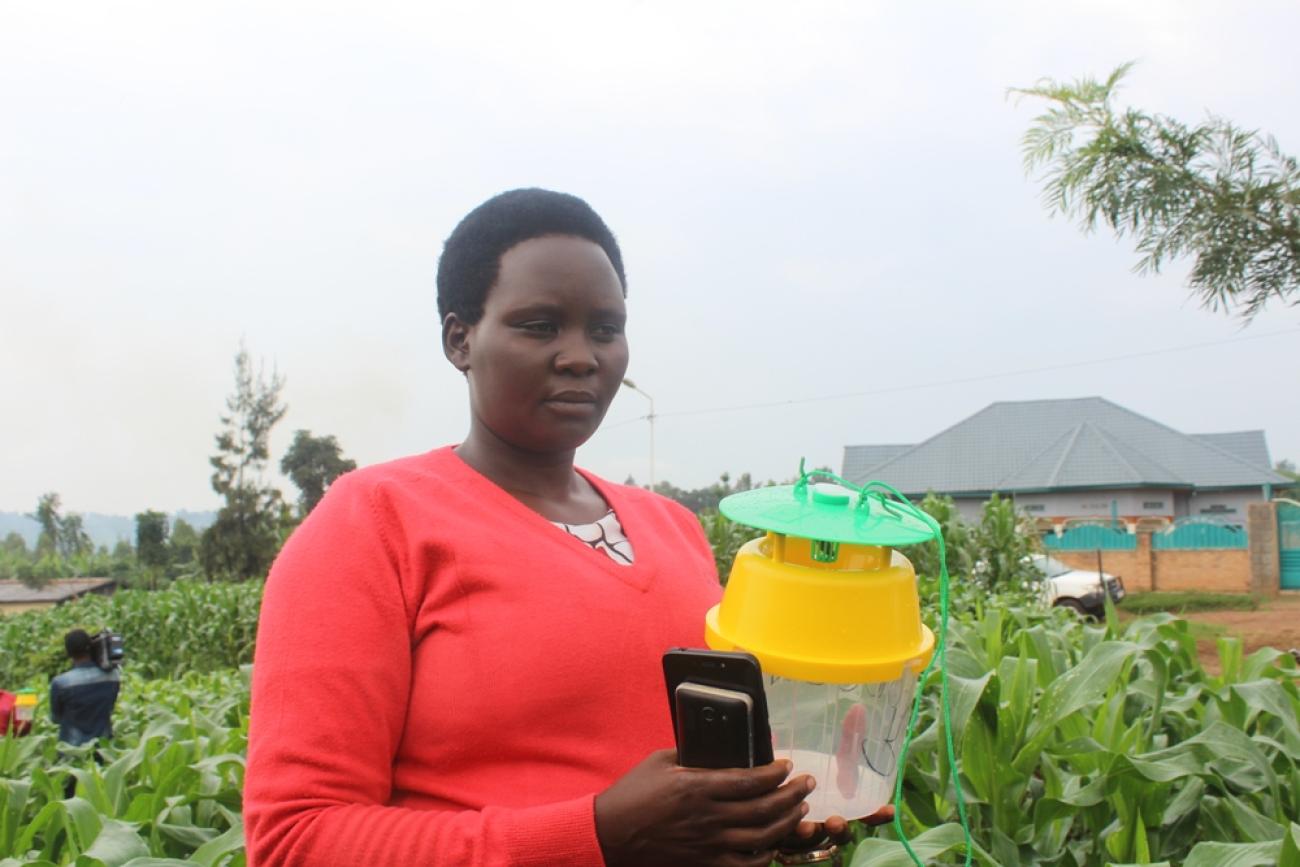Farmers receive pheromone traps and mobile phones with an app to fight Fall armyworm

FAO has distributed pheromone traps and lures to farmers from the six districts in Rwanda most affected by the Fall Armyworm (FAW).
The districts are Nyamagabe, Nyanza, Muhanga, Rwamagana, Nyagatare and Kayonza located in Southern and Eastern Provinces.
Under the project 'Support to the Government of Rwanda in sustainable control and management of Fall Armyworm', FAO also gave farmers 60 mobile phones, fully-installed with Fall Armyworm Monitoring and Early Warning System (FAMEWS) mobile application, to enable them detect and report the level of infestation in their farms.
FAMEWS is a global platform to share experience about FAW and ecology, to know FAW situation and risk mapping.
The project
The project seeks to to distribute 1,800 pheromone traps and 21,600 lures in all the six districts.
The new technologies are given to farmers as they prepare for the forthcoming planting Season B (February–June) 2019.
The pheromone traps and lures mostly target male moths, because they are the ones responsible for reproduction through mating the female ones to produce larvae of Fall Armyworm. These traps will also serve as an early warning system for the timely actions of FAW management, to define FAW infested areas, to track build-up of FAW population, to determine FAW movement patterns and identify areas at high risk.
Since the outbreak of the Fall Armyworm in Rwanda in 2017, many maize farmers particularly, have experienced reduced production and productivity and consequently incurring huge financial losses.
Ntambara Geoffrey is a maize farmer in Karangazi sector, Nyagatare district. He was supplying quality maize seeds to Rwanda Agriculture Board (RAB) that were used for farmers in the country. However, when the Fall Armyworm invaded his farm, the seeds lost quality and he consequently lost his reliable market.
“I used to harvest 28 tons of maize from my 10 hectare land. However, during the agriculture Season B 2018, we found our maize eaten up by insects. I got only 4 tons - losing over 6 million Rwandan francs approximately (USD 7,000)”, says Geoffrey.
Ruhima Stephen, another farmer from the same district, lost production of 15 tons: his yield from his 12 hectare of maize went from 18 tons to 3 tons.
He had bought each kilogram of the maize seeds at Rwfr520/kg but sold at a loss.
“When we harvested, the seeds were already damaged. Rwanda Agriculture Board (RAB) were not willing to buy our affected seeds, so we resorted to selling to ordinary markets at a giveaway price of Rwfr180/kg”, says Stephen.
FAO Assistant Representative, Otto Muhinda, said:
“Scouting for Fall Armyworm is necessary in fields where larvae or their damage are noted. The application of an insecticide is usually not economical for control of the fall armyworm. However, it may be necessary if the infestation is extremely severe and/or the plants are under stress”
Hope for better harvests
Farmers from the target districts have been undergoing training on the use of the Fall Armyworm application, plus how to get the most out of the pheromone traps.
Why FAMEWS?
FAMEWS will help farmers and extension officers to collect and record information when scouting fields and checking pheromone traps for Fall Armyworm (FAW).
Philip Swahibu, a farmer from Muyumbu sector, Rwamagana district, explains that because of reduction of eggs production, less caterpillars will become developed, meaning less effect on the crops. Meanwhile, Jeanette Uwamariya is a farmer from one of Kayonza’s maize farming sites, she says:
“The traps will help us to know how much infestation is in our farms. Thus, we will be alert. The traps are also environmental friendly: we’re going to install the traps when we plant the maize, this will lessen the devastation.”








